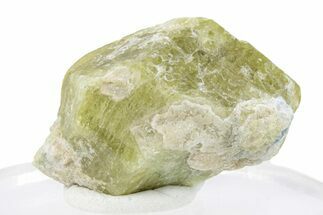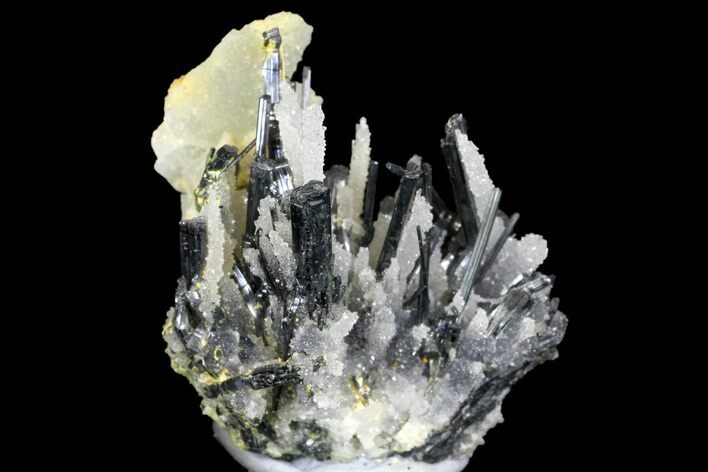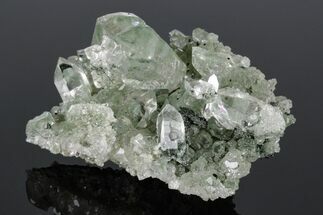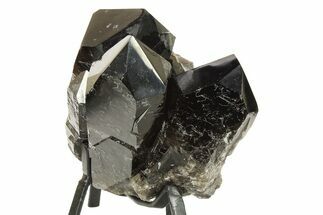This Specimen has been sold.
1.1" Metallic Stibnite and Druzy Quartz - China
This is a gorgeous cluster of stibnite crystals with druzy quartz crystal formation, collected from China. The stibnite crystals have great metallic luster, fine striations and are in overall good shape. This specimen comes on a piece of mineral tack within an acrylic perky display case.
About Stibnite
Stibnite is a striking mineral composed of antimony sulfide and is best known for its metallic luster and dramatic, elongated crystal formations. It often forms slender, prismatic crystals that can cluster into stunning radiating or parallel groups. Its color ranges from silvery-gray to steel-blue, with a reflective sheen that enhances its visual appeal. Stibnite is relatively soft, with a Mohs hardness of 2, making it easy to scratch but still prized for its aesthetic qualities.
This mineral has been historically significant as a primary source of antimony, a metal used in alloys, flame retardants, and batteries. Stibnite specimens are highly sought after by collectors due to their unique appearance and rarity. Major localities include China, Japan, and the United States, with some of the finest examples originating from the Wuning Mine in Jiangxi Province, China. Despite its beauty, stibnite contains toxic antimony and should be handled with care.
Toxicity Warning: Stibnite (antimony) is toxic and can be harmful if inhaled or swallowed. Most of the risk is long-term, chronic exposure to its dust. While a crystal sitting on your shelf doesn't pose a health risk, you should wash your hands after handling, keep out of reach of children, and please don't lick the stibnites.
Stibnite is a striking mineral composed of antimony sulfide and is best known for its metallic luster and dramatic, elongated crystal formations. It often forms slender, prismatic crystals that can cluster into stunning radiating or parallel groups. Its color ranges from silvery-gray to steel-blue, with a reflective sheen that enhances its visual appeal. Stibnite is relatively soft, with a Mohs hardness of 2, making it easy to scratch but still prized for its aesthetic qualities.
This mineral has been historically significant as a primary source of antimony, a metal used in alloys, flame retardants, and batteries. Stibnite specimens are highly sought after by collectors due to their unique appearance and rarity. Major localities include China, Japan, and the United States, with some of the finest examples originating from the Wuning Mine in Jiangxi Province, China. Despite its beauty, stibnite contains toxic antimony and should be handled with care.
Toxicity Warning: Stibnite (antimony) is toxic and can be harmful if inhaled or swallowed. Most of the risk is long-term, chronic exposure to its dust. While a crystal sitting on your shelf doesn't pose a health risk, you should wash your hands after handling, keep out of reach of children, and please don't lick the stibnites.
About Quartz
Quartz is the name given to silicon dioxide (SiO2) and is the second most abundant mineral in the Earth's crust. Quartz crystals generally grow in silica-rich environments--usually igneous rocks or hydrothermal environments like geothermal waters--at temperatures between 100°C and 450°C, and usually under very high pressure. In either case, crystals will precipitate as temperatures cool, just as ice gradually forms when water freezes. Quartz veins are formed when open fissures are filled with hot water during the closing stages of mountain formation: these veins can be hundreds of millions of years old.
Quartz is the name given to silicon dioxide (SiO2) and is the second most abundant mineral in the Earth's crust. Quartz crystals generally grow in silica-rich environments--usually igneous rocks or hydrothermal environments like geothermal waters--at temperatures between 100°C and 450°C, and usually under very high pressure. In either case, crystals will precipitate as temperatures cool, just as ice gradually forms when water freezes. Quartz veins are formed when open fissures are filled with hot water during the closing stages of mountain formation: these veins can be hundreds of millions of years old.
 Reviews
Reviews












